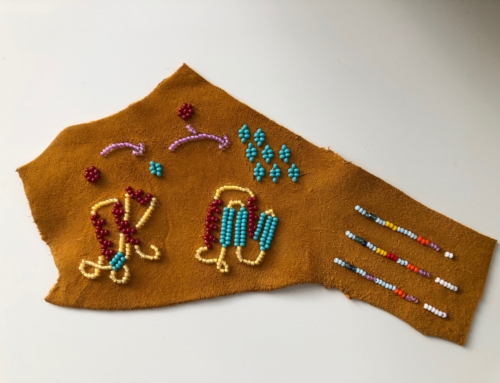
photo: jonathan goldberg-hiller
On April 12, 2011 I organized (in concert with UC Berkeley’s Science, Technology, and Society Center–STSC) this syposium that brought together animal studies scholars in queer and critical race studies with scholars working within longer-lived indigenous approaches to knowing “nonhumans.” Below are the opening remarks that I presented at the symposium. Following are links to the iTunes podcasts of the events:

Opening Comments
Kim TallBear, UC Berkeley
I have organized this morning’s symposium with the Science Technology and Society Center (STSC) here at Berkeley under Cori Hayden’s leadership (with tons of help from our student assistant Judith Gray). Our purpose is to bring into the center of this burgeoning field of animal studies empirical analyses of human/nonhuman relations—indeed socialrelations—that privilege frameworks of critical race theory, queer theory, and indigenous and post-colonial (or is that anti-colonial?) theory.
The last decade has seen an upsurge of important scholarship in the field of “animal studies.” Under this rubric, scholars with roots in a variety of disciplines from across the spectrum of the social sciences and humanities attempt to recover knowledge territory claimed by and for the natural sciences alone over the last several hundred years. Today, we have scholars representing (and surely their allegiances bleed across disciplinary lines) library and information sciences, cultural studies, political science, linguistics, Africana studies, Gender & Women studies, sexuality studies, and Native American and Indigenous Studies. There is also prominent scholarship in this field coming from anthropology, geography, and multidisciplinary environmental studies. Not to mention the actual social lives lived by both humans and nonhuman persons (if I can borrow language from indigenous ontologies) that will influence today’s conversation.
Within this already critical field of animal studies, thinkers aim essentially to dismantle hierarchiesin therelationships of “westerners” with their non-human others. A prime example is the recent move to “multi-species ethnography” by anthropologists, geographers, and other social scientists. Scholars apply anthropological approaches to studying humans, to the social relations (not simply “interactions”) between humans and nonhumans, located in their social and physical habitats. As S. Eben Kirksey and Stefan Helmreich comment in the introduction to the recent Cultural Anthropology special issue on the topic, new anthropological accounts are starting to appear in which nonhumans (animals, plants, fungi, and microbes) previously relegated to the status of “bare life” or “that which is killable” are now appearing “alongside humans in the realm of bios, with legibly biographical and political lives” (545).[1] In short, “multispecies ethnography centers on how a multitude of organisms’ livelihoods shape and are shaped by political, economic, and cultural forces.” Organisms have livelihoods. Our panelist, Scout Calvert’s scholarship on the work done to cattle and the work that cattle do in our industrial meat complex – and the effects on the lives of cattle and humans – can be understood within this tradition.
This work is both methodologically and ethically innovative. Yet is also has starting points that can only partially contain indigenous standpoints, and thus the importance of bringing indigenous voices to this table. One contribution of indigenous studies is to localize human/nonhuman relations in cultural, political contexts. Anthropologist Paul Nadasdy’s study of the Kluane First Nation and other Arctic hunting peoples is instructive here.[2] Nadasdy documents reciprocal exchanges (sometimes coupled with domination and its elements of coercion, deceit, and danger) between northern hunters and nonhuman persons who they know to be “thinking beings.” Sometimes these beings “consciously give themselves to hunters,” sometimes they have to be outwitted. Very importantly, Nadasdy explains hunting societies’ ontologies (what they know) rather than their beliefs about the world. And he calls anthropologists to beware of their own discrediting languages that would see animal gifts to humans as metaphor rather than reality. A second contribution is to extend the range of nonhuman beings with which we can be in relation. Much animal studies work restricts its attention to beings that “live,” e.g. dogs, bears, mushrooms, microorganisms. It is animal studies after all. But for many indigenous peoples, our nonhuman others may not be understood in even critical western frameworks as living. Nadasdy is primarily concerned with human and animal prey, but he also acknowledges similar relations among northern indigenous people and other “objects” and “forces” (trees, stones, thunder, etc.) which are known to be “sentient and intelligent persons” (29). Like our methodological choices, language choices are ethical choices and are key in this project of constituting more democratic relations and worlds. Indeed, animal studies may be an inadequate construction for capturing human and nonhuman relations across cultures.
The idea then behind this symposium is to bring together scholars within animal studies who focus on queer and critical race approaches with scholars working within longer-lived strands of study, indigenous approaches to knowing “nonhumans” that are focused on critiquing settler colonialism and its management of nonhuman others. For example, Zakkiyah Jackson brings together queer theory, African diasporic feminism and animal studies to look at how black gender is animalized. Critical race theory, queer theory and indigenous studies—including Noenoe Silva and Jon Goldberg Hiller’s work on Native Hawaiian ontologies and relations with sharks and pigs (in distinction to state “natural resource” management of these beings)—all seek to disrupt the division between human and animal. These critical approaches make the link between dualisms and the relegation of certain humans to the realm of less-than-human, to the realm of the animal. Violence against animals is linked to violence against particular humans who have historically been linked to animality. There are real implications, as these speakers will show, for who and what gets to live, and who and what gets to die when the human/animal split is made.
There are multiple theorists who I need to thank for spurring my thinking on this topic and for being (whether they know it or not) inspirational for this symposium: these are my academic colleagues in the world of animal studies, including all of you on this panel. They also include my friend and colleague S. Eben Kirksey (co-editor of the special Cultural Anthropology issue on multispecies ethnography), who in true feminist tradition is always quick to share theoretical insights, ethnographic contacts, and other opportunities in order to proliferate the thinking and innovation in this field.
Equally importantly though, I have been spurred to interest in this topic by individuals who would not consider themselves part of the animal studies scholarly world, indeed some are not even in the academy, but their work and lives are chiefly oriented towards Native American and indigenous self-determination. As part of that broader goal, these thinkers live and/or theorize social relations between humans and nonhuman persons.
Two important names come to mind: First, is the noted Native American scholar, Vine Deloria, Jr., who, in his theorizing of the concept of “American Indian metaphysics,” refuses the binary so integral to our dominant culture—that of science versus religion—or material versus immaterial.[3] For Deloria, those terms might apply to the West that in its particular history has insisted on severing “religion” from “science,” erecting a hard barrier between what humans can know through their materialistic, empirical investigations and what is believed to exist beyond the known material world. In disrupting the science/religion divide in American Indian thought, Deloria’s theorizing implicates a second boundary, that between human and nonhuman persons. Deloria writes of the importance of social relations (not simply interactions) between “animals,” “energy,” “spirits,” “rocks,” “stars,” in the constitution of American Indian knowledge about the world. Deloria’s theorizing allows for conversations and analyses of meaningful relations between humans and nonhumans, including beings not classed as animate, that are not explicable wholly by materialist science.
These conversations have implications on both ethical and methodological levels (indeed methods are ethics) for how we inquire formally and for how we live. If nonhuman persons’ animacy (to use Mel Chen’s term) is taken seriously, can our scientific hypotheses be expanded, and thus our knowledges made more multi-cultural and potentially more robust? Second, what are the implications for how we live with and among the variety of our human and nonhuman kin who have been variously animated and de-animated in our sciences, religions, and governance structures?
A second important influence comes from outside the academy. My colleague and friend, Oglala Lakota architect and Lakota studies expert, Craig Howe, argues with me about Vine Deloria’s intentions. He pushes me to refine my theoretical musings. Yet he has eschewed the mainstream academic life to found the Center for American Indian Research and Native Studies (CAIRNS), which he built on his family’s land between the Rosebud and Pine Ridge Indian reservations in South Dakota. In addition to running Lakota and Native American studies workshops at his facility, Howe lives in daily contact with a host of nonhumans on that land and documents those relations weekly in his blog, Oko Iyawapi (or week count). Whether Howe engages with rabbits who pointedly observe him when he works outside, who alternately take afternoon naps in the shade of his structures, and sometimes thwart his architectural projects with their own work—their adamant digging; whether he studies the lodges of spiders, so akin to tipis in their form; or whether he follows the movements of star people in relation to distant buttes as he plots and builds the structures of the CAIRNS facility, Howe’s documentation of his daily entanglements with mindful nonhumans along with his theoretical challenges inspire my thinking in this area.
This symposium evinces the idea that indigenous theorizing can and should be brought to the same conversational table with feminist, queer, and critical race approaches in order to understand our co-constitution across species lines—or for indigenous ways of knowing, between kinds of persons. It is my hope that these critical approaches can together help us take these border and boundary confusions one step further.
Returning to non-indigenous influences, I (and probably most of us) owe an intellectual debt to a major theorist in this area, Donna Haraway. Her Cyborg Manifesto reminds us that “social reality is lived social relations, our most important political construction, a world-changing fiction” (149).[4] Haraway’s object of attention in that famous essay was a hybrid of machine and organism. “The cyborg,” she noted, “is our ontology; it gives us our politics” (150). Back in the early 1990s, after 200 hundred years of evolutionary theory, Haraway argued that “the divide between human and animal was thoroughly breached” (151), thus making room for the proliferation of cyborgs, both literally and figuratively, in our culture. Cyborgs were also born of a second breach, that between animals/humans (or organisms) and machines (152). Haraway called attention to a third boundary made fluid—that “between physical and non-physical” (153). Writing of electronic worlds such as those co-constituted with the goings on in Silicon Valley, Haraway was outside of but resonant with indigenous theorizing that has never given itself up to the binary of material realism vs. immaterial myth.
Haraway asks us not to be “afraid of [our] joint kinship with [both] animals and machines, not [to be] afraid of permanently partial identities and contradictory standpoints.” Similarly to Vine Deloria, she writes against binaries that proliferate in non-indigenous cultures. Hers include self/other, mind/body, culture/nature, male/female, civilized/primitive, active/passive, agent/resource. She calls us to see from multiple standpoints at once for this kind of “double vision” is more rigorous. “It reveals both dominations and possibilities unimaginable” from a single standpoint” (154). What is more, this isn’t just about what is just, it’s also about pleasure. Haraway argues that we should take “pleasure in the confusion of boundaries and… responsibility in their construction” (150).
Yet Alutiq archaeologist Sven Haakenson reminds us in the Grizzly Man film[5] that Timothy Treadwell, who lived among bears for many summers in Alaska and co-founded the Grizzly People organization, was killed and eaten by a bear precisely because he disrespected a boundary between human and bear communities that Alaska Natives have lived with for millennia. That boundary crossing resulted in that same bear later being shot by the U.S. Park Service. Treadwell would have abhorred the killing of the bear. Which boundaries get crossed? Who takes what agency in particular boundary confusions? Haraway’s call to not only take pleasure, but also responsibility echoes in my head.[6]
I know this is becoming cliché, but I am going to repeat it anyway for there is no better way to say this more concisely: our particular co-constitutions of human and nonhuman matter for who lives and dies in this world, and how. The approaches highlighted in this symposium bring yet a wider array of standpoints into this important conversation that is thriving in the academy, but fortunately is not contained by it.
I look forward to our conversations today and into the future as these scholars and their intellectual compatriots continue to challenge us to (re)think our relations “between kin and kind,” and hopefully even the regulatory regimes that are implicated by these relatings.
[1] S. Eben Kirksey and Stefan Helmreich, “The Emergence of Multispecies Ethnography,” Cultural Anthropology 25(4): 545-576.
[2] Paul Nadasdy, “The Gift in the Animal: The Ontology of Hunting and Human-Animal Sociality,” American Ethnologist 34(1) (February 2007): 25-43.
[3]Vine Deloria, Jr., “American Indian Metaphysics,” in Power and Place: Indian Education in America, ed. Vine Deloria, Jr. and Daniel R. Wildcat (Golden, CO: Fulcrum Publishing, 2001), 1-6.
[4] Donna J. Haraway, “A Cyborg Manifesto: Science, Technology, and Socialist-Feminism in the Late Twentieth Century,” in Simians, Cyborgs, and Women: the Reinvention of Nature, Donna J. Haraway (New York and London: Routledge, 1991), , 149-181.
[5] Grizzly Man by Werner Herzog, 2005 (100 min.)
[6] This paragraph was not in my remarks delivered orally at the symposium. I have added them to this written transcript for clarification.



